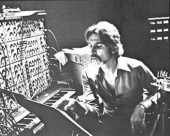Dr. Patrick Gleeson
Location:
LOS ANGELES, California, US
Type:
Artist / Band / Musician
Genre:
Electronica / Jazz / Experimental
In 1968, jazz legend Herbie Hancock left Miles Davis' band (after 5 years) to pursue his solo career. Hancock's concept quickly moved deeper into electronic/jazz fusion and was perfected with the addition to his band of Dr. Patrick Gleeson. Dr. Gleeson performed on Moog and Arp synthesizers, old-school analog modular types, which were capable of creating a myriad of sounds that had never really been heard in a jazz/improv context. These sounds, as represented on the albums "Crossings" and "Sextant", from 1971/72, were brimming with abstract imagery both alien and organic. Although Hancock & Miles Davis both were reportedly influenced by avant garde composer, Karlheinz Stockhausen, it was Patrick Gleeson who truly brought the sonic world of Stockhausen to jazz music and created new definitions for the word "fusion".
Patrick Gleeson: ".much credit is due Herbie for big ears and hearing what it was I was doing and incorporating it into his band (from Crossings to Sextant and a few guest recording appearances afterward, none of significance after Sextant). But they weren't Herbie's innovations, they were mine. I fought my way into the band (even Herbie's rock/funk oriented producer, David Rubinson, initially had doubts), and when I first joined the band, Downbeat slammed Crossings, saying "the less said about the synth player the better," and then a year and a half later nominated me for outstanding new jazz artist and called me a pioneer of electronic jazz--which was literally true: I was the first guy there. But history has apparently decided otherwise (which is why we need better historians) and I've been "disappeared" in favor of a simpler story, where Herbie introduced synths to jazz. Not quite."
"I joined Herbie's band as Crossings was being recorded--much to the displeasure of the rest of the band (who are now my lifelong friends). At the first rehearsal Buster Williams, Herbie's incredible bass player, said, "What do you call that thing anyway?" "An Arp 2600." Buster glared and said, "Well, it sounds like a big vacuum cleaner." The earliest critical responses were in the same vein. The downbeat reviewer was particularly merciless. Then after we'd toured the album for almost a year something very strange happened. Kids would come back stage and want to know where they could buy what I was playing. Downbeat nominated me for outstanding new jazz artist! At that point synths had made their way into funk and jazz. Now, some thirty-five years later, I look back on this album with such pride--for my contribution, for the band's excellence generally,for Herbie's brilliance as a player--at this point no jazz piano player in the world was any better-- and for Herbie's open-mindedness in hiring this weird academic geek and turning him into a jazz musician. I've played on something like 200 albums since, and this for me was absolutely the best: composition, performance, conception certainly and also for the brotherhood it engendered among the players. "Sextant" was also good, and probably even more electronic, but from a player's viewpoint this album is a once-in-a-lifetime experience."
Arp 2600 Analog Synthesizer
Moog Modular Analog Synthesizer
Copyright © BANDMINE // All Right Reserved
